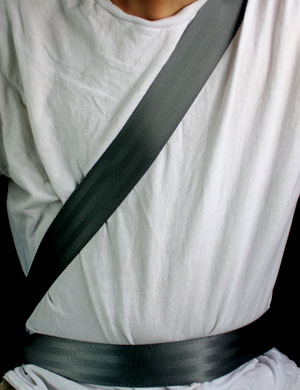As the car spun in full-circle, she opened her eyes to a red liquid covering her body.
On Jan. 7; senior Amy Comstock was making a left turn from Kaley Avenue onto Summerlin Road. However, she didn’t see the red truck heading towards her. The truck slammed into the passenger side where senior Caley Brock was sitting, spinning the car in a full circle.
“I screamed ‘Amy!’ and the next thing I remember was a crunch and it felt like a roller coaster,” Brock said. “It was so scary; remembering it feels like a dream, not real and fuzzy.”
According to Brock, she saw the truck coming towards them at a speed of 40 miles per hour but did not think the truck would actually hit them.
“I saw how big the truck was and how fast it was going but, at the same time, I just kept thinking we’d dodge the accident and avoid it,” Brock said. “When I opened my eyes, I was in complete shock.”
Both Comstock and Brock opened their eyes to what they finally realized to be salsa from the leftovers of a meal they were holding, not blood, covering them. Yet, they did not know what to do from there.
“I instantly thought of the mock DUI and how they say don’t move, so I didn’t know what to do; it was just scary,” Brock said.
According to the U.S. Department of Transportation, 5,474 people were killed and 448,000 people were injured in 2009 in car crashes involving distracting driving.
“[I feel the main cause of car accidents are] driving distractions: radios, cell phones and other passengers; it’s easy to get distracted by other things around you,” School Resource Officer Scott Daniels said. “[People need to] drive defensively and be aware of what other drivers are doing; slow down, make space and don’t tailgate. Assume the worst and take action.”
“I [only] have partial memory of the accident, but I’m sure if I had taken a split second longer to check and make sure there were no cars, I would have stopped without the chance of an accident happening,” Comstock said.
Although Comstock’s car spun in full-circle, both Brock and she walked away from the accident with only a few minor cuts on their hips from the tightening of their seat belts.
“In my case, [I feel] the seat belt definitely helped; I wasn’t thrown forward or to the side like I could’ve been. It held me in place where I needed to be to stay safe,” Comstock said.
On Feb. 6, the lack of a seat belt caused a tragedy that has resonated throughout the entire community. Driving on I-4, former senior, Laura Grant, lost control of her car. Both she and passenger, Edward Culberhouse, class of 2009, died on impact. Passengers Elizabeth Harrison and Alisa Pelot were in the Intensive Care Unit at the local Orlando Regional Healthcare Center, while junior Connor Geis and Billy Keeton were able to walk away with minor injuries.
Although the cause of the accident is still unknown, the autopsy results came back on March 10, showing Grant had no alcohol in her system. However, none of the six students had one a seatbelt, which could have drastically changed the outcome of this accident.
“I wish [Laura] would’ve been wearing [her seat belt] because she would have had a better chance of surviving,” senior Shelby Miller said. “She usually wore her seat belt whenever I was in the car with her, so it was really a shock that she wasn’t.”
According to the National Safety Council, 42 percent of vehicle passengers killed in 2007 due to car accidents were unbelted. A 2009 study by the National Highway Traffic Safety Administration showed that on estimate, more than 1,600 lives could be saved and 22,000 injuries could be prevented by the use of a seat belt.
“Before I was always too worried about being late or I didn’t even notice to put my seat belt on, but losing Laura this year makes me conscious of putting [it] on every time I drive and I don’t let anyone ride in my car without one,” Miller said.
To make students aware of seat belt safety, Principal Margaret McMillen requested random seat belt checks in the student parking lot.
“I think students are more aware of the importance of seat belts right now, so this is a good time to re-educate everyone about not only the law, but the safety benefits of wearing seat belts,” Dr. McMillen said.
According to Daniels, resource officers will start checking the student parking lot to see if every passenger is wearing a seatbelt. Those caught not wearing it may not receive a ticket; however, they will be reminded to wear it. Anywhere off-campus, one can receive a ticket for not wearing a belt, something McMillen is trying to prevent, along with injuries and fatalities.
Although seat belts are crucial, being able to control a car is more important. One must be aware of car issues including tires, brakes and oil. However, driving safety courses allow one to be prepared for the worst.
“[Driving courses should] be enforced. It helps you develop reaction times in a controlled environment,” Daniels said. “[Driving courses help] to avoid certain situations and how to get out of [them].”
According to Daniels, driving courses teach one to recognize what is happening and what to do in real life situations.
Being aware of the road is always a key factor along with paying attention to one’s speed.
“Speed is always a factor, especially with boys,” Daniels said. “Slow down and pay attention. [You] need to focus and not worry about phone calls, make-up the radio and etcetera.”
